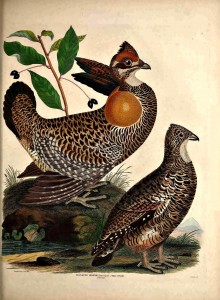The story of the last Passenger Pigeon and the disappearance of the Great Auk, Carolina Parakeet, and Heath Hen reveal the fragile connections between species and their environment. To help tell their story, the Smithsonian Libraries, Biodiversity Heritage Library, and the National Museum of Natural History have curated a joint exhibit entitled Once There Were Billions: Vanished Birds of North America which opened June 24 in the National Museum of Natural History.
Heath Hen: Early Signs of Trouble
During colonial times, Heath Hens (Tympanuchus cupido cupido) flourished among the heathland barrens of coastal North America from Maine to Virginia. Tasty and easy to kill, they were popular among early settler, and their numbers quickly declined from overhunting, habitat loss, and disease.

In 1791, the New York State legislature introduced a bill calling for the preservation of Heath Hens and other game, but it couldn’t be enforced. After the birds disappeared from the mainland, a Heath Hen sanctuary was established on Martha’s Vineyard in 1908. The sanctuary was home to the entire Heath Hen population–50 birds in all. By 1915, they numbered 2,000. But when a fire destroyed the sanctuary’s habitat in 1916, their numbers dwindled. The last one died in 1932.
Extinctions are often most visible to us when they affect a highly visible species in our communities, especially if there are repercussions for our food sources or income. But extinctions can also have far-reaching impacts that may not be as immediately visible.
Understanding Biodiversity and Supporting Research
One way to better understanding biodiversity and its significance is to support organizations like the Biodiversity Heritage Library. BHL is a global project that is changing the way research is done, by digitizing and providing open access to biodiversity literature. BHL makes more than 44 million pages and nearly 100,000 scientific illustrations–of animals and plants, living and extinct–freely available to scientists and others around the world. BHL relies on donations from individuals to support scanning of the biodiversity literature held in some of the world’s most renowned natural history and botanical libraries. To learn more about how your donation supports the continued growth of BHL, please visit http://archive.constantcontact.com/fs181/1103622715135/archive/1115465985290.html. We hope you’ll consider making a donation today!

Be First to Comment